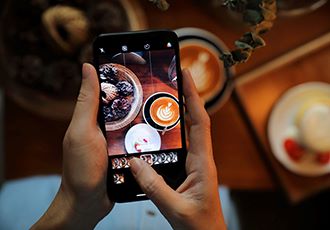Digital food photography may make us eat healthier
We view, create and share pictures of our food like never before. In a new literature review, researchers suggest that the phenomenon of #foodporn, if used wisely, may help us develop a healthier and more satisfying relationship with food.

Have you ever taken a photo of your meal and shared it with followers, friends and family?
On Instagram and direct digital communication, it is becoming increasingly popular to participate actively in food content creation instead of mere passive consumption.
A bombardment of appetizing food images and photography - commonly referred to as #foodporn - has therefore become a significant aspect of our digital food experience. One might therefore ask whether this influences our actual eating behavior, and if so, how?
This is the topic of a new literature review by researchers from Aarhus University:
- We offer the view that active participation in food photography, together with a selective use of food-related digital media, might contribute to healthy body weight management and enhanced meal pleasure, says PhD Student Tjark Andersen from the science team Food Quality Perception and Society at the Department of Food Science.
Viewing food images affects appetite
This comprehensive review concludes that viewing food photography can induce psychological responses similar to seeing real food. While viewing a few food images can stimulate appetite, viewing many images may induce feelings of satiety or fullness from eating. Moreover, this satiety is restricted to the specific sensory experience in question: viewing images of salty snacks may therefore reduce the appetite for fries without reducing the appetite for cookies or candy.
These effects on our satiety have the potential to influence our eating behavior in a positive way, if used wisely. However, they depend on our (spontaneous) mental simulation of eating the depicted food, and differences in image composition can make a substantial difference for the extent or ease of mental simulation:
- There are many significant elements in composition. For example, research has shown that depicted social cues modulate the interaction between viewing food images and eating behavior. Seeing images of others’ eating unhealthy food might increase social acceptability - and this can promote unhealthy eating behavior, Tjark Andersen says.
Creating food images affects attention and pleasure
Photography, in general, increases the engagement in and enjoyment of experiences, according to research included in the review, and it tends to amplify the value of experiences, making positive experiences more positive and negative experiences more negative.
It is the intention to photograph itself that directs attention towards valuable visual aspects of an experience, and engaging in food photography can therefore both increase the eater’s attention on the food and amplify the pleasure of eating.
- This effect seems to also depend on the consumption goal, for example, whether people, at least implicitly, eat for pleasure or for health. Like any other behavior, eating is goal-directed. Only when the meal is congruent with the consumption goal does photography lead to increased enjoyment, says Tjark Andersen.
Furthermore, the act of food photography should interfere as little as possible with the eating experience, and photo editing and uploading might best be delayed until after the meal, research suggests.
- Based on this literature review, we hypothesize that, by going through the effort of taking a photograph of the food, people will feel more responsible for their food choices, leading to greater satisfaction in the moment and healthier eating behavior over time, says Assistant Professor Qian Janice Wang, who is the main scientific supervisor behind the review.
And that is not the only possible benefit:
- The photography-induced increase in attention might improve memory - an important aspect for long-term bodyweight management. In this context, we see it as critical to review previously consumed food’s photos before meals, Tjark Andersen adds.
Sharing food images needs to be explored
While the phenomena of viewing and creating food photography are underpinned by research, the eating behavioral effect of sharing food photos has yet to be studied directly:
- We can only speculate how the sharing of food photography over social media may influence eating behavior. Existing research in commensality and, more broadly, social psychology suggest that food photography sharing could negatively influence food choice and eating pleasure. An example of this is in relation to eating disorders, where people can digitally receive emotional support from peers - but, at the same time, social media amplifies the natural tendency for social comparison, which can make the maintenance of a favorable public presence more important than the intended purpose of supporting recovery, says Derek V. Byrne, who is leader of the science team Food Quality Perception:
- Furthermore, research has shown how merely intending to take photos for sharing can reduce the enjoyment of an experience compared to taking photos for personal use, as it can make people self-conscious rather than enjoying the experience, but further research is needed to scrutinize the effects of food photography sharing.
| Additional information | |
|---|---|
| We strive to ensure that all our articles live up to the Danish universities' principles for good research communication (scroll down to find the English version on the web-site). Because of this the article will be supplemented with the following information: | |
| Study type | Literature review |
| Funding | This research project was supported by the Graduate School of Technical Sciences, Aarhus University, the Sino-Danish Center of Education and Research (SDC), and Aarhus University’s Centre for Innovative Food Research (CiFOOD). |
| Samarbejdspartnere | Department of Food Science, Aarhus University |
| Read more | Read more in the scientific article: “How Digital Food Affects Our Analog Lives: The Impact of Food Photography on Healthy Eating Behavior”. Frontiers in Psychology, 12, 980, by Tjark Andersen, Derek V. Byrne & Qian Janice Wang. |
| Contact | Tjark Andersen, PhD Student, Department of Food Science, Aarhus University, tandersen@food.au.dk |
